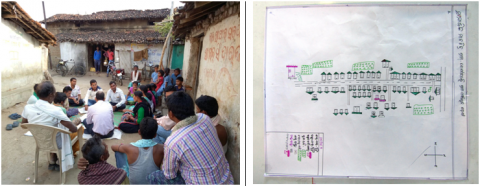
The qualitative association of Tata Trusts and the Labour and ESI Dept., Govt. of Odisha has taken the initiative of bringing a synchronization into the lives of the migrant labourers from the unorganized sectors of Odisha. The intervention has been made into their livelihoods and settlement with a priority. This partnership extends the intervention of Trusts into education, healthcare and nutrition and rural livelihoods of the migrating labourers. This bonding intends toward the welfare of the working classes; especially who are belonging to the unorganized sector.
Through the social mapping of the Gram Panchayats in the districts of Nuapada and Bolangir, it intends to portray a social picture of the villages which in turn benefits in the further process of development in those respective areas. The team has encountered 10 Gram Panchayats of Nuapada and 20 Gram Panchayats of Bolangir. The map focuses on the accurate number of Migrant households and Non-migrant households with a priority. The collection of data also includes a keen insight into drinking water facility, utility places, agricultural field allocation and distribution patterns of the village dwellers. It depicts a clear idea of natural resources in and around the living area. The demarcation of functional and non-functional tube wells provide an outlook to the availability of the water resources in those villages.
The primary objective of constructing these social maps is to identify and understand the household types (Migrant households/ Non-migrant households), while the secondary purposes include the pattern of households (Pucca house/ Semi-Pucca house/ Kuchcha house), drinking water facility (Functional/ Non-functional tube wells), distribution of land (Forest/ Agricultural land/ Grazing land/ Common land/ Barren land), Migrant households owning/not owning agricultural land of 0.5 acres and Revenue villages which have acute migration rates (let’s say >70%, >60% or >50%). The social status (SC/ST/OBC) composition of the migratory households, female headed households which are migratory in nature and the poorest of the poor families are well depicted in the maps. While throwing a light to the public utility places, it spots, educational institutions, hospitals and Govt. offices in the premises.
The purpose of the social mapping of the Gram Panchayats intends to figure out the availability of Seasonal hostels and Anganwadi centers for the care and nourishment of children of migrating labourers. This participatory action provides a real picture and rapid assessment of the present scenario of the villages which helps the organization to comprehend the available resources for the migrating labourers and their children in the villages. In anticipation to this, the further progressive steps of developing these under-developed and unorganized parts of Odisha can be taken.
These social maps are compiled and verified by the GP level support team (i.e., Asha workers and Aganwadi volunteers) in contemplation with BDO. Around 240 volunteers from the respective villages are selected and trained on this to complete the social mapping exercise.
This partnership aims towards the development of the lifestyle of the migrating labourers and their families, including their children. It implies to the welfare of the working classes in the respective districts. The program will be scaled up and replicated in all other migration prone districts in a phased manner.